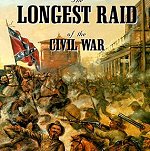 The Longest Raid of the Civil War: Little-Known & Untold Stories of Morgan's Raid into Kentucky, Indiana & Ohio Kentucky, a slave state, did not secede. Many were pro Confederate however. Jefferson Davis was from Kentucky, Lincoln was also born there. |
Buffington Island
|
|
|
|
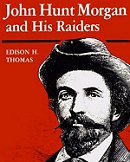
|
On July 13, Morgan's raiders crossed into Ohio at Harrison, pursued by several columns of Union cavalry under overall direction of Brig. Gen. Edward H. Hobson. On July 19, Kautz's and Judah's brigades attacked Morgan near Buffington Island. During the night, Morgan and about 400 men escaped encirclement by following a narrow woods path. The rest of his force surrendered. Result(s): Union victory Location: Meigs County Campaign: Morgan's Raid in Kentucky, Indiana, and Ohio (July 1863) Date(s): July 19, 1863 Principal Commanders: Brig. General Edward H. Hobson [US]; Brig. General John Hunt Morgan [CS] Forces Engaged: Brigades: 4,700 total (US 3,000; CS 1,700) Estimated Casualties: 925 total (US 25; CS 900) |
 Civil War Model 1851 Naval Pistol Engraved Silver Tone / Gold Tone Finish and Wooden Grips - Replica of Revolver Used by Both USA / Union and CSA / Confederate Forces |
Ohio State Battle Map State Battle Maps Civil War Summary Underground Railroad American Civil War Exhibits Confederate Commanders Civil War Timeline Women in the War |
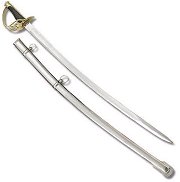 Cavalry Saber This fine replica is 39 inches overall and features a highly polished 33 inch carbon steel blade. Its leather wrapped handle fits the hand perfectly and sports decorative brass accents and a shiny brass pommel. |
Kindle Available John Hunt Morgan and His Raiders The "Thunderbolt of the Confederacy" John Hunt Morgan from Tompkinsville, Kentucky to Greeneville, Tennessee. |
 A Light and Uncertain Hold: A History of the Sixty-Sixth Ohio Volunteer Infantry Thackery weaves all the historical information into a story from the formation of the 66th to it's exit muster and beyond. He uses an excellent mix of excerpts from letters home, local period newspaper articles, and various historical volumes particularly from Ohio libraries |
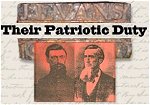 Their Patriotic Duty: The Civil War Letters of the Evans Family of Brown County, Ohio Many of the farm families in the river country of southern Ohio sent fathers, husbands, and sons to fight and die in the Civil War. Few families have bequeathed a record of that experience as remarkable as that created by the Evans family: an extraordinary collection of letters that offers a unique portrait of life both on the home front and on the front lines |
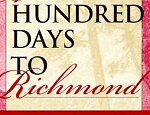 A Hundred Days to Richmond: Ohio's "Hundred Days" Men in the Civil War The complete story of Ohio's "100-day men"--state militia troops who were offered for Union service for 100 days. Their individual tales are unique and memorable, and their voices unmistakably American. |
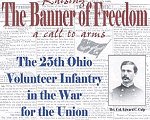 Raising the Banner of Freedom: The 25th Ohio Volunteer Infantry in the War for the Union The story of the American Civil War is best told by those who lived it. Colonel Culp brings us telling accounts of the 25th Ohio Volunteer Infantry, cited as one of the 300 fighting regiments of the Civil War. |
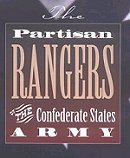 The Partisan Rangers of the Confederate States Army: Memoirs of General Adam R. Johnson The capture of Newburg, Indiana, with only twelve men and two joints of stovepipe mounted on the running gear of a wagon. This episode won him a nickname of "Stovepipe." He was promoted to Brigadier General in June 1864 |
Kindle Available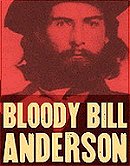 Bloody Bill Anderson: The Short, Savage Life of a Civil War Guerrilla For a brief but dramatic period, Bloody Bill played the leading role in the most violent arena of the entire war-and did so with a vicious abandon that spread fear throughout the land |
Kindle Available Jesse James: Last Rebel of the Civil War This places James within a specific political context, showing why it was possible for this murderous bandit to emerge as a folk hero among Southern sympathizers following the Civil War in which he fought as a teenager |
| Search AmericanCivilWar.com |
| Enter the keywords you are looking for and the site will be searched and all occurrences of your request will be displayed. You can also enter a date format, April 19,1862 or September 1864. |